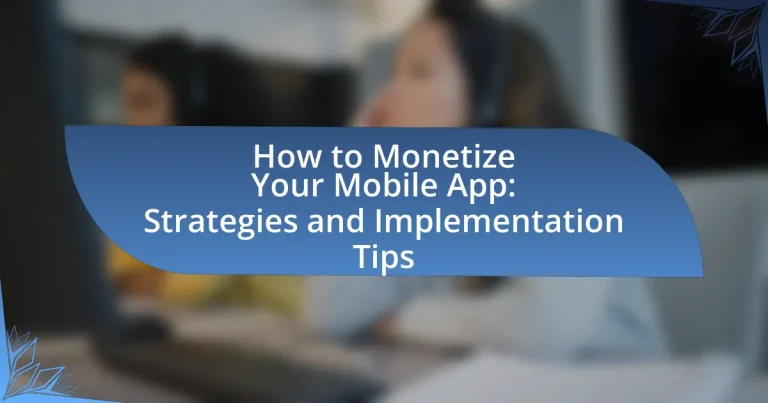The article focuses on effective strategies for monetizing mobile apps, detailing key methods such as in-app purchases, subscription models, advertising, and sponsorships. It explores the mechanics of different monetization models, the importance of understanding target audiences, and how user behavior influences revenue generation. Additionally, the article discusses the role of app design in monetization success, implementation tips for integrating ads, and best practices for enhancing user retention and engagement. Legal considerations and troubleshooting monetization issues are also addressed, providing a comprehensive guide for developers seeking to optimize their app’s financial performance.

What are the key strategies for monetizing your mobile app?
The key strategies for monetizing your mobile app include in-app purchases, subscription models, advertising, and sponsorships. In-app purchases allow users to buy virtual goods or premium features, which can significantly boost revenue; for example, games often use this model to enhance user experience. Subscription models provide a steady income stream by charging users a recurring fee for access to content or services, with successful apps like Netflix demonstrating this approach. Advertising generates revenue by displaying ads within the app, leveraging platforms like Google AdMob, which reported that mobile ads can yield high returns if targeted effectively. Sponsorships involve partnering with brands to promote their products within the app, creating a mutually beneficial relationship that can enhance user engagement while generating income. Each of these strategies has proven effective in the mobile app market, as evidenced by the diverse revenue streams of top-grossing apps.
How do different monetization models work?
Different monetization models work by providing various methods for generating revenue from mobile apps. Common models include in-app purchases, where users buy virtual goods or features; subscription services, which charge users a recurring fee for access to content or services; and ad-based monetization, where apps display advertisements and earn revenue based on impressions or clicks. For instance, according to a report by Statista, in-app purchases accounted for approximately 48% of global app revenue in 2021, demonstrating the effectiveness of this model. Each model has its own mechanics and user engagement strategies, influencing how developers choose to monetize their applications.
What are the differences between in-app purchases and subscriptions?
In-app purchases are one-time transactions that allow users to buy virtual goods or features within an app, while subscriptions are recurring payments that grant users access to content or services over a specified period. In-app purchases typically involve buying items like game currency or premium features, whereas subscriptions often provide ongoing access to services, such as streaming content or premium app features, for a set duration, such as monthly or annually. According to a report by Statista, in-app purchases accounted for 48% of mobile app revenue in 2021, highlighting their significance in monetization strategies, while subscriptions have been increasingly popular, with subscription-based apps generating over $13 billion in revenue in 2020, indicating a growing trend in user preference for ongoing access.
How does advertising revenue generation function in mobile apps?
Advertising revenue generation in mobile apps functions primarily through the integration of ad networks that serve advertisements to users within the app. These ad networks, such as Google AdMob or Facebook Audience Network, connect app developers with advertisers looking to promote their products or services.
When users interact with the app, ads are displayed based on various targeting criteria, including user demographics and behavior. Revenue is generated through different models, such as Cost Per Click (CPC), where developers earn money each time a user clicks on an ad, or Cost Per Mille (CPM), where revenue is earned based on the number of impressions served, typically measured per thousand views.
According to Statista, mobile advertising spending is projected to reach over $400 billion by 2024, highlighting the significant financial potential for app developers leveraging advertising as a monetization strategy.
Why is understanding your target audience crucial for monetization?
Understanding your target audience is crucial for monetization because it enables businesses to tailor their products and marketing strategies to meet the specific needs and preferences of potential customers. By identifying the demographics, behaviors, and pain points of the target audience, companies can create more relevant offerings that resonate with users, leading to higher engagement and conversion rates. For instance, a study by eMarketer found that personalized marketing can increase conversion rates by up to 10 times, demonstrating the financial impact of understanding audience preferences. This targeted approach not only enhances user satisfaction but also maximizes revenue potential through effective pricing strategies and advertising placements that align with audience interests.
What methods can you use to identify your app’s target audience?
To identify your app’s target audience, you can utilize methods such as market research, user surveys, and analytics tools. Market research involves analyzing industry trends and competitor demographics to understand potential users. User surveys collect direct feedback from existing or potential users about their preferences and needs, providing valuable insights into audience characteristics. Analytics tools, like Google Analytics or app-specific platforms, track user behavior and demographics, helping to refine audience profiles based on actual usage data. These methods are effective as they provide concrete data and insights that can guide app development and marketing strategies.
How does user behavior influence monetization strategies?
User behavior significantly influences monetization strategies by dictating how users interact with an app and what features they value. For instance, data shows that users who frequently engage with in-app purchases are more likely to respond positively to targeted offers, leading to increased revenue. Additionally, understanding user preferences through analytics allows developers to tailor subscription models or ad placements that align with user habits, enhancing user satisfaction and retention. Research indicates that apps that adapt their monetization strategies based on user behavior can see up to a 30% increase in revenue, demonstrating the critical link between user actions and effective monetization approaches.
What role does app design play in monetization success?
App design plays a critical role in monetization success by directly influencing user engagement and retention. A well-designed app enhances user experience, leading to higher usage rates and increased likelihood of in-app purchases or subscriptions. According to a study by Apptentive, apps with intuitive navigation and appealing aesthetics see a 30% increase in user retention, which is essential for generating revenue. Furthermore, effective app design can facilitate smoother transactions and promote upselling opportunities, ultimately driving higher revenue streams.
How can user experience impact revenue generation?
User experience significantly impacts revenue generation by influencing customer satisfaction and retention. A positive user experience leads to higher engagement rates, which can result in increased purchases and subscriptions. For instance, a study by McKinsey found that companies that prioritize user experience see revenue growth rates of 5 to 10 times faster than their competitors. Additionally, according to a report by Forrester, every dollar invested in user experience can yield a return of up to $100, demonstrating the direct correlation between effective user experience design and financial performance.
What design elements encourage in-app purchases?
Design elements that encourage in-app purchases include visually appealing interfaces, clear calls-to-action, and strategic placement of purchase options. Visually appealing interfaces attract users and enhance their experience, making them more likely to engage with the app and consider purchases. Clear calls-to-action guide users toward making purchases by highlighting benefits and creating urgency, such as limited-time offers. Additionally, strategically placing purchase options within the app, such as in high-traffic areas or during key moments of user engagement, increases visibility and accessibility, leading to higher conversion rates. Research indicates that apps with well-designed user interfaces can see a 200% increase in user engagement, which correlates with increased in-app purchases.

What are the implementation tips for effective monetization?
To effectively monetize a mobile app, implement a combination of strategies including in-app purchases, subscription models, and ad placements. In-app purchases allow users to buy virtual goods or features, which can significantly boost revenue; for instance, games often utilize this model successfully, generating billions in revenue annually. Subscription models provide a steady income stream by charging users on a recurring basis for premium content or features, with services like Spotify demonstrating the effectiveness of this approach. Additionally, integrating ads can generate revenue without requiring users to pay directly, as evidenced by free apps that leverage ad networks to monetize their user base. Each of these strategies should be tailored to the target audience and app type to maximize effectiveness.
How can you effectively integrate ads into your app?
To effectively integrate ads into your app, utilize a combination of ad formats that align with user experience and app functionality. Implementing banner ads, interstitial ads, and rewarded video ads can maximize revenue while maintaining user engagement. Research indicates that apps using a mix of ad types see a 30% increase in user retention compared to those using a single format. Additionally, placing ads in non-intrusive locations, such as at natural transition points in the app, enhances user satisfaction and reduces the likelihood of ad fatigue.
What are the best practices for ad placement?
The best practices for ad placement include strategically positioning ads to maximize visibility and engagement without disrupting user experience. Effective ad placement should consider factors such as user behavior, app layout, and ad format. For instance, placing ads in natural breaks within content, such as between levels in a game or during transitions in a video, can enhance user acceptance. Research indicates that ads placed above the fold, where users are likely to see them without scrolling, achieve higher click-through rates. Additionally, using native ads that blend seamlessly with app content can improve user interaction and reduce ad fatigue.
How do you choose the right ad networks for your app?
To choose the right ad networks for your app, evaluate factors such as audience targeting, ad formats, revenue potential, and network reputation. Audience targeting ensures that the ads reach users who are likely to engage, while diverse ad formats, like banners and interstitials, can enhance user experience and monetization. Revenue potential can be assessed through eCPM (effective cost per mille) rates, which vary by network and can significantly impact earnings. Additionally, researching network reputation through reviews and case studies can provide insights into reliability and support. For instance, networks like AdMob and Facebook Audience Network are known for their robust targeting capabilities and high eCPM rates, making them popular choices among app developers.
What strategies can enhance user retention and increase revenue?
Implementing personalized user experiences significantly enhances user retention and increases revenue. Personalization strategies, such as tailored content recommendations and targeted push notifications, have been shown to boost engagement rates by up to 50%. Additionally, offering loyalty programs and in-app rewards can incentivize users to return, with studies indicating that loyal customers are worth up to ten times their first purchase. Furthermore, optimizing onboarding processes ensures users understand the app’s value quickly, leading to a 30% increase in retention rates. These strategies collectively create a more engaging user experience, driving both retention and revenue growth.
How can push notifications be used to drive engagement?
Push notifications can drive engagement by delivering timely and relevant content directly to users’ devices, prompting immediate interaction. For instance, personalized notifications about app updates, special offers, or reminders can significantly increase user activity; studies show that users who enable push notifications engage with apps 88% more than those who do not. Additionally, strategic timing and frequency of notifications can enhance user retention, as research indicates that well-timed messages can lead to a 20% increase in app usage.
What loyalty programs can incentivize users to spend more?
Loyalty programs that can incentivize users to spend more include tiered rewards programs, cashback offers, and points-based systems. Tiered rewards programs encourage increased spending by providing escalating benefits as users reach higher spending thresholds, which can lead to a 20% increase in customer retention according to a study by Bond Brand Loyalty. Cashback offers provide immediate financial incentives, motivating users to make larger purchases to receive a percentage back, with research indicating that 70% of consumers prefer cashback over other rewards. Points-based systems allow users to accumulate points for every purchase, which can be redeemed for discounts or exclusive products, driving repeat purchases and increasing overall spending.
How do you measure the success of your monetization strategies?
To measure the success of monetization strategies, key performance indicators (KPIs) such as revenue growth, user acquisition cost, and customer lifetime value are analyzed. Revenue growth indicates the effectiveness of pricing models and user engagement, while user acquisition cost assesses the efficiency of marketing efforts. Customer lifetime value reflects the long-term profitability of users, providing insight into retention and engagement strategies. According to a study by App Annie, mobile app revenue reached $170 billion in 2021, highlighting the importance of effective monetization strategies in achieving financial success.
What key performance indicators should you track?
Key performance indicators (KPIs) to track for monetizing a mobile app include user acquisition cost, lifetime value of a customer, retention rate, daily active users, and average revenue per user. User acquisition cost measures the expense incurred to gain a new user, which is crucial for assessing marketing efficiency. Lifetime value of a customer indicates the total revenue expected from a user throughout their engagement with the app, helping to determine long-term profitability. Retention rate reflects the percentage of users who continue using the app over time, highlighting user satisfaction and engagement. Daily active users provide insight into the app’s popularity and user engagement levels, while average revenue per user quantifies the revenue generated per user, essential for evaluating monetization strategies. Tracking these KPIs allows app developers to make informed decisions and optimize their monetization efforts effectively.
How can A/B testing improve your monetization efforts?
A/B testing can significantly enhance monetization efforts by allowing businesses to identify the most effective strategies for maximizing revenue. By comparing two or more variations of app features, pricing models, or ad placements, companies can determine which option yields higher user engagement and conversion rates. For instance, a study by Optimizely found that A/B testing can lead to conversion rate improvements of up to 49%. This data-driven approach enables businesses to make informed decisions, optimize user experiences, and ultimately increase their revenue streams.

What common challenges do developers face in app monetization?
Developers face several common challenges in app monetization, including user acquisition costs, balancing user experience with monetization strategies, and competition in the app market. High user acquisition costs can significantly impact profitability, as developers often spend substantial amounts on marketing to attract users. Additionally, developers must carefully balance monetization methods, such as ads or in-app purchases, with maintaining a positive user experience; intrusive ads can lead to user dissatisfaction and churn. Furthermore, the competitive landscape makes it difficult for new apps to stand out, as established apps often dominate the market, making it challenging for developers to gain visibility and attract users.
How can you overcome user resistance to in-app purchases?
To overcome user resistance to in-app purchases, developers should focus on enhancing the perceived value of the purchases. This can be achieved by offering exclusive content, features, or experiences that significantly improve user engagement and satisfaction. Research indicates that 70% of users are more likely to make in-app purchases when they perceive a clear benefit, such as enhanced gameplay or access to premium content. Additionally, implementing a transparent pricing strategy and providing users with free trials or limited-time offers can further reduce resistance, as users feel they are making informed decisions.
What strategies can help justify the cost of in-app purchases?
To justify the cost of in-app purchases, developers can implement value-driven strategies that enhance user experience and engagement. Offering exclusive content, such as premium features or unique items, creates a perception of added value, encouraging users to invest. Additionally, providing tiered pricing options allows users to choose purchases that align with their budget and needs, increasing the likelihood of conversion.
Research indicates that 70% of mobile app revenue comes from in-app purchases, highlighting the importance of effective monetization strategies. Furthermore, incorporating user feedback to refine offerings can lead to higher satisfaction and retention rates, ultimately justifying the costs associated with in-app purchases.
How can you address negative user feedback regarding monetization?
To address negative user feedback regarding monetization, developers should actively engage with users to understand their concerns and implement changes based on their feedback. This can involve conducting surveys to gather specific insights about user dissatisfaction, which can help identify common issues such as pricing, ad frequency, or perceived value. For instance, a study by Apptentive found that 77% of users are more likely to leave positive feedback if they feel their concerns are acknowledged. By responding to feedback and making adjustments, such as offering more flexible pricing options or reducing intrusive ads, developers can improve user satisfaction and retention.
What are the legal considerations in app monetization?
Legal considerations in app monetization include compliance with data protection laws, intellectual property rights, and consumer protection regulations. App developers must adhere to regulations such as the General Data Protection Regulation (GDPR) in Europe, which mandates user consent for data collection and processing. Additionally, developers should ensure that their monetization strategies, such as in-app purchases or advertisements, do not infringe on copyright or trademark laws. Consumer protection laws require transparency in pricing and clear communication regarding subscription terms. Failure to comply with these legal frameworks can result in significant fines and legal action, highlighting the importance of understanding and implementing these considerations in app monetization strategies.
How do privacy regulations affect ad monetization?
Privacy regulations significantly impact ad monetization by restricting the collection and use of personal data for targeted advertising. These regulations, such as the General Data Protection Regulation (GDPR) in Europe and the California Consumer Privacy Act (CCPA) in the United States, require companies to obtain explicit consent from users before processing their data. This leads to a decrease in the availability of user data, which in turn reduces the effectiveness of targeted ads and can lower ad revenues. For instance, a study by eMarketer found that 63% of marketers reported a negative impact on their ad targeting capabilities due to privacy regulations, resulting in less efficient ad spend and diminished return on investment.
What guidelines should you follow to ensure compliance?
To ensure compliance when monetizing your mobile app, follow guidelines that include adhering to data protection regulations, obtaining necessary permissions for monetization strategies, and ensuring transparency with users. Compliance with data protection regulations, such as the General Data Protection Regulation (GDPR) in Europe, mandates that app developers must secure user consent for data collection and provide clear privacy policies. Additionally, obtaining permissions for monetization strategies, such as in-app purchases or advertisements, is crucial to avoid legal repercussions. Transparency with users about how their data will be used and how monetization affects their experience is essential for maintaining trust and compliance with consumer protection laws.
What are the best practices for troubleshooting monetization issues?
The best practices for troubleshooting monetization issues include analyzing user data, reviewing monetization strategies, and conducting A/B testing. Analyzing user data helps identify patterns in user behavior that may affect revenue, such as drop-off points or engagement levels. Reviewing monetization strategies ensures that the chosen methods, such as in-app purchases or ads, align with user expectations and market trends. Conducting A/B testing allows developers to experiment with different pricing models or ad placements to determine which options yield the highest revenue. These practices are supported by industry reports indicating that data-driven decisions can increase app revenue by up to 30%.
How can you identify and fix low conversion rates?
To identify and fix low conversion rates, analyze user behavior through analytics tools to pinpoint where users drop off in the conversion funnel. For instance, Google Analytics can reveal high exit rates on specific pages, indicating potential issues. Once identified, implement A/B testing to experiment with different elements such as call-to-action buttons, page layouts, or content to determine what drives higher conversions. Research shows that optimizing landing pages can increase conversion rates by up to 300%. Additionally, gather user feedback through surveys to understand pain points and address them directly, enhancing the overall user experience and increasing conversion rates.
What steps can you take to improve user engagement and spending?
To improve user engagement and spending, implement personalized experiences through data-driven insights. Personalization increases user satisfaction and retention; for instance, apps that utilize user data to tailor content see a 20% increase in engagement rates. Additionally, integrating gamification elements, such as rewards and challenges, can enhance user interaction and encourage spending, as evidenced by a study showing that gamified apps can boost user retention by up to 30%. Regularly updating content and features also keeps users interested, with 60% of users more likely to engage with apps that frequently refresh their offerings.


